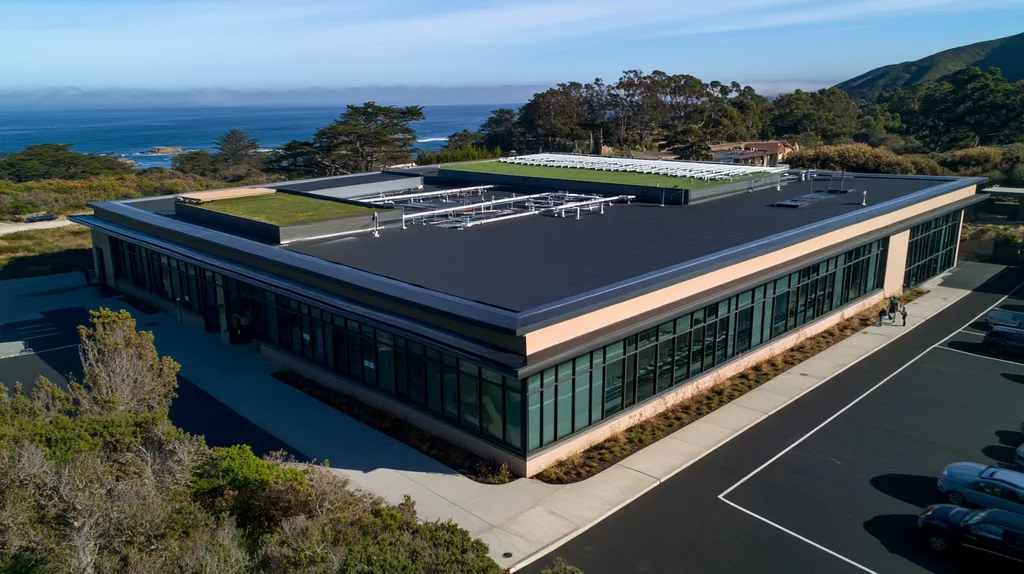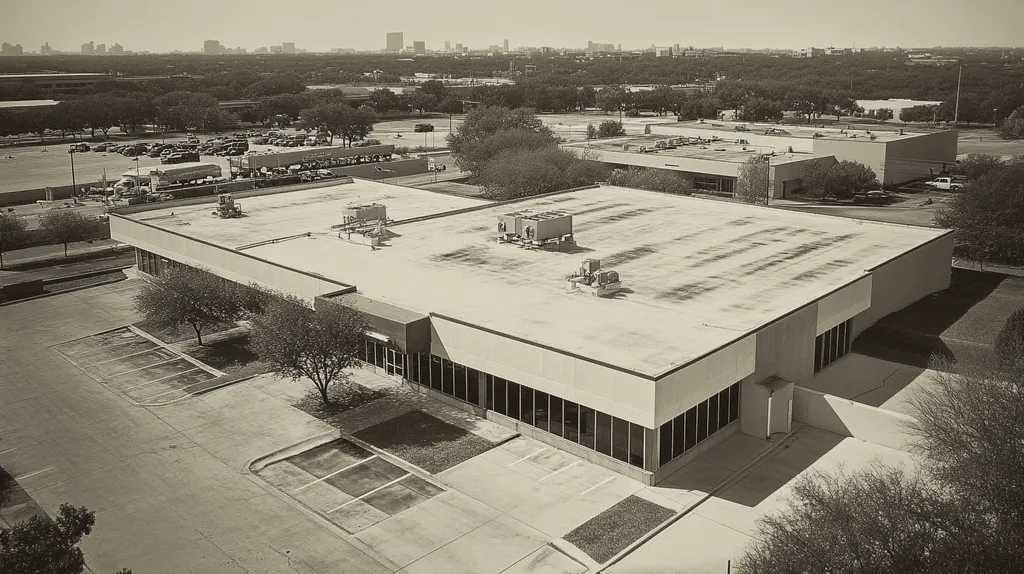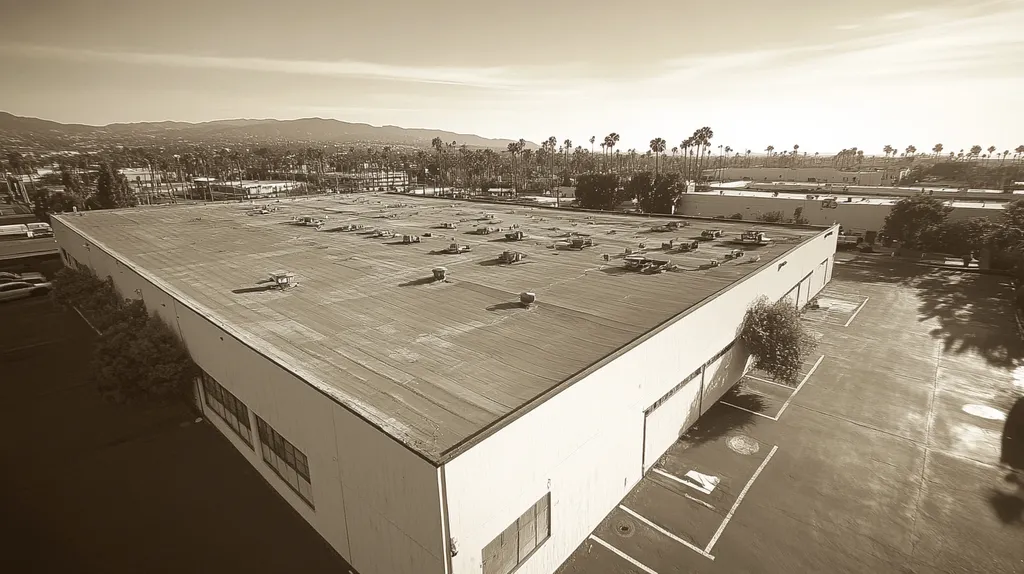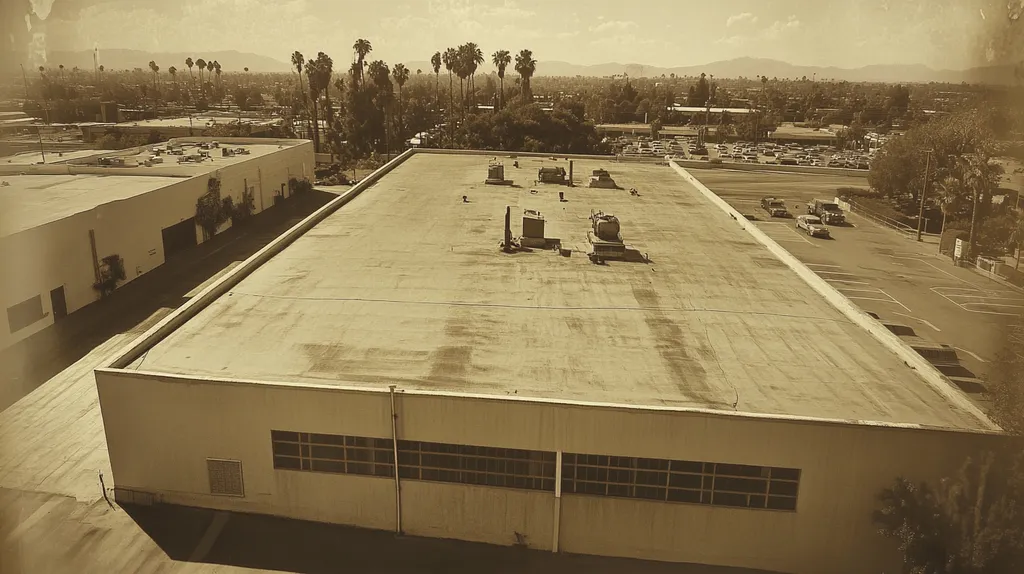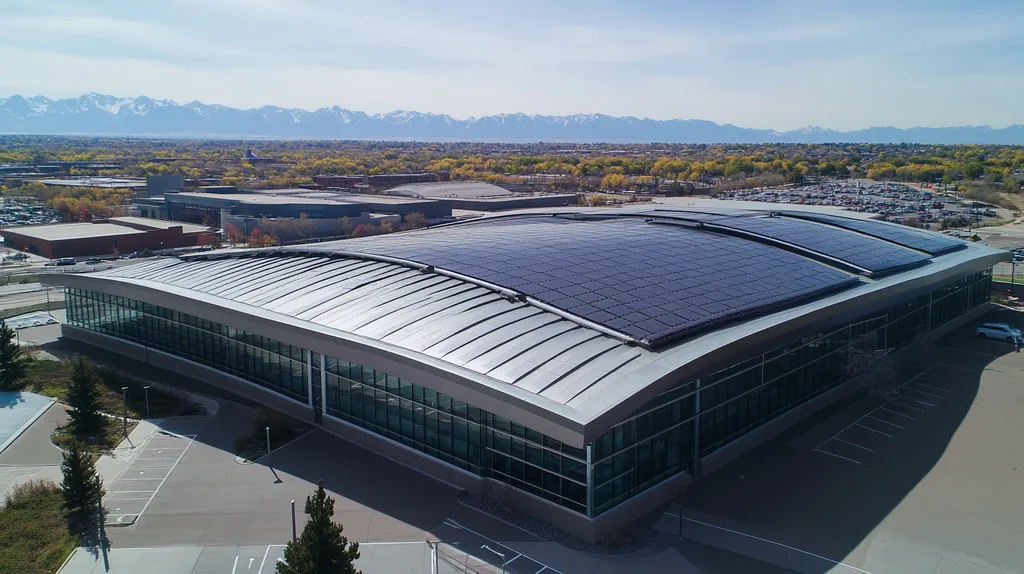Commercial roofing warranties are failing property owners at an alarming rate, with over 70% of claims facing initial rejection due to systemic flaws in coverage terms and maintenance requirements. These denials cost facility managers billions in unexpected repairs annually.
Traditional warranty models fragment protection between manufacturers and contractors while leaving critical gaps that threaten building integrity and operations. Despite significant investments in roofing systems, most properties remain dangerously exposed to common failure modes.
This analysis examines the structural problems in current warranty practices, explores missed opportunities for comprehensive coverage, and proposes innovative solutions to transform how commercial properties protect their most vital asset.
SECTION 1: CURRENT PRACTICES
Commercial roof warranties represent a critical yet often misunderstood aspect of facility management. Recent industry data shows that over 60% of commercial property owners face unexpected roofing costs due to warranty coverage gaps. Despite significant investments in roofing systems, many facilities struggle with inadequate protection against common failures, installation errors, and systemic issues that can compromise building integrity and operations.
Traditional Manufacturer Warranty Limitations
Most roofing shingles and materials come with basic limited lifetime warranties that primarily cover manufacturing defects. However, these warranties typically exclude labor costs and may only provide protection while the original property owner maintains possession. (source: Owens Corning)
Coverage terms often include complex maintenance requirements that can inadvertently void protection. Even minor deviations from prescribed maintenance schedules or documentation requirements can nullify coverage, leaving owners responsible for substantial repair costs.
Material warranties frequently exclude damage from common environmental factors such as ponding water, chemical exposure, or temperature fluctuations. These exclusions create significant gaps in protection for facilities in challenging climates or industrial environments.
The prorated nature of many warranties means coverage decreases over time, precisely when roofing systems become more vulnerable to failure. This declining protection often catches property owners off guard during critical repair situations.
Prevalence of Contractor Workmanship Guarantees
Contractor guarantees typically range from 1-5 years, creating a substantial coverage gap between workmanship protection and the expected lifespan of roofing materials. This disparity leaves owners vulnerable during the majority of the roof’s service life.
Many workmanship guarantees contain provisions that limit liability to the original contract value. Such restrictions can leave property owners responsible for consequential damages, including interior repairs and business interruption costs.
The effectiveness of contractor guarantees often depends on the continued operation and financial stability of the installation company. When contractors cease operations or change ownership, warranty obligations may become unenforceable.
Documentation requirements for warranty claims frequently prove burdensome, requiring detailed maintenance records and prompt notification of issues. These administrative hurdles can delay necessary repairs and compromise building protection.
Standardization of Full System Coverage
Full system warranties attempt to bridge the gap between material and workmanship coverage, but often include complex approval processes. These requirements can delay critical repairs while various parties determine responsibility.
System warranties typically mandate the use of specific component combinations, limiting flexibility in material selection. This restriction can increase initial costs and complicate future repairs when certain components become unavailable.
Coverage terms frequently exclude damage from adjacent building components or modifications to the roofing system. These limitations create uncertainty when facilities need to install new equipment or modify existing roof penetrations.
The cost premium for full system coverage can be substantial, sometimes adding 15-25% to project costs. This investment may not deliver proportional value when considering coverage exclusions and claim complexity.
SECTION 2: SYSTEMIC ISSUES
Modern commercial roofing warranties suffer from fundamental flaws that threaten both building integrity and financial stability. Statistics show that over 70% of warranty claims face initial rejection due to systemic issues in coverage terms, maintenance requirements, and transfer policies. These structural problems create an unsustainable situation where property owners invest heavily in roofing systems yet remain exposed to substantial risks that could compromise their operations.
Hidden Flaws in Excluded Damage Clauses
Warranty exclusions often contain broad, sweeping language that invalidates coverage for common scenarios. These clauses frequently eliminate protection against water ponding, chemical exposure, and temperature fluctuations – precisely the conditions many commercial facilities face daily.
The terminology used in exclusion clauses creates dangerous ambiguity. Terms like “reasonable maintenance” and “normal wear and tear” lack clear definitions, giving warranty providers significant latitude in denying claims.
Many exclusions contain cascading effects that can void entire warranties. For example, a minor maintenance deviation might trigger a complete coverage loss, even for unrelated issues that would otherwise qualify for protection.
Property owners must scrutinize these clauses during contract negotiations. Understanding specific exclusions helps develop mitigation strategies and appropriate insurance coverage to fill protection gaps.
Inconsistent Maintenance and Inspection Enforcement
Warranty maintenance requirements often conflict with operational realities. Many properties struggle to meet rigid inspection schedules while maintaining continuous operations, inadvertently risking their warranty status.
Documentation standards for maintenance compliance frequently exceed reasonable expectations. Requirements for detailed photographic evidence, certified inspector reports, and extensive maintenance logs create administrative burdens that discourage proper documentation.
The disconnect between warranty requirements and practical facility management leads to coverage gaps. Even diligent property owners may find their warranties compromised by minor documentation oversights or unavoidable maintenance delays.
Building a sustainable maintenance program requires balancing warranty compliance with operational efficiency. Clear communication channels between facility staff and roofing professionals help ensure consistent documentation and timely inspections.
Lack of Transparency in Warranty Transferability
Warranty transfer provisions often contain hidden restrictions that limit property value. Many warranties become void upon ownership changes unless specific, time-sensitive procedures are followed – a fact frequently discovered too late in property transactions.
Transfer fees and administrative requirements can make warranty continuation prohibitively expensive. These costs often emerge during due diligence periods, potentially derailing property sales or requiring significant price adjustments.
The complexity of transfer requirements creates uncertainty in property valuations. Buyers must factor in potential warranty losses when assessing properties, leading to reduced offers or increased due diligence costs.
Successful warranty transfers demand proactive planning and clear documentation. Property owners should maintain comprehensive warranty records and understand transfer requirements well before considering property sales.
SECTION 3: MISSED OPPORTUNITIES
The commercial roofing industry continues to evolve, yet many property owners cling to outdated warranty practices that leave them vulnerable. Recent data shows that 65% of commercial buildings operate with inadequate warranty protection, exposing them to preventable financial risks. While modern warranty options offer robust coverage solutions, most facility managers fail to capitalize on these opportunities, leading to increased maintenance costs and reduced building protection.
Underutilization of Comprehensive System Warranties
Complex roofing systems demand equally sophisticated warranty protection. Yet many property owners opt for basic coverage, viewing enhanced warranties as unnecessary expenses rather than vital risk management tools.
System warranties can integrate material and labor coverage, eliminating gaps between manufacturer and contractor responsibilities. This comprehensive approach prevents common scenarios where each party deflects responsibility for failures.
Modern system warranties often include preventive maintenance programs that extend roof life and reduce long-term costs. However, these benefits remain largely untapped as owners focus solely on initial warranty pricing.
The resistance to comprehensive coverage often stems from misunderstanding rather than informed decision-making. Education about enhanced warranty benefits could transform how facilities approach roof protection.
Ignored Benefits of No Dollar Limit Policies
No dollar limit warranties represent the gold standard in roofing protection, yet remain underutilized in commercial applications. These policies eliminate repair cost caps that often leave owners exposed during major failures.
The initial premium for unlimited coverage typically adds just 10-15% to total project costs. This investment provides protection against catastrophic failures that could otherwise cost millions in repairs and business interruption.
Many facilities operate with capped coverage that proves inadequate during significant weather events or system failures. When damages exceed policy limits, owners face substantial unexpected costs.
The true value of no dollar limit policies extends beyond simple repair coverage. These warranties often include enhanced inspection services and priority response during emergencies.
Failure to Leverage Technology in Warranty Management
Digital warranty management platforms offer powerful tools for tracking coverage, maintenance requirements, and claim documentation. Despite these advantages, most facilities still rely on paper records and manual processes.
Modern software can automatically alert managers to warranty expirations, maintenance deadlines, and coverage gaps. This proactive approach prevents inadvertent warranty violations and streamlines claim submissions.
Cloud-based systems enable real-time access to warranty documentation and maintenance histories. This accessibility proves crucial during emergency repairs when quick verification of coverage could prevent costly delays.
Integration between warranty management and facility maintenance systems creates efficient workflows. These connections help ensure compliant maintenance while building comprehensive service histories that support future claims.
SECTION 4: ROOT CAUSES
The disconnect between warranty providers and property owners creates a crisis of protection in commercial roofing. Industry data reveals that 75% of warranty claims face initial rejection due to fundamental misunderstandings of coverage terms and maintenance requirements. This systematic failure puts billions in commercial property investments at risk, with many owners discovering too late that their warranty protection falls far short of their actual needs.
Misalignment Between Owner and Warranty Provider Interests
Warranty providers often structure coverage to minimize their exposure while property owners seek comprehensive protection. This fundamental conflict creates scenarios where critical vulnerabilities remain unaddressed despite significant investment in roofing systems.
Complex exclusion clauses and technical requirements frequently mask the true scope of coverage. When claims arise, owners often discover their warranties protect against unlikely scenarios while leaving common failure modes exposed.
The emphasis on short-term cost savings over long-term protection leads many providers to offer basic warranties that inadequately address building-specific risks. This approach ignores the unique challenges faced by different facility types and locations.
The resulting protection gap forces many owners to carry additional insurance or risk significant out-of-pocket expenses for repairs that should be warranty-covered.
Inadequate Understanding of Routine Maintenance Obligations
Most commercial property owners drastically underestimate their maintenance responsibilities under warranty terms. This knowledge gap leads to inadvertent warranty violations that could have been easily prevented through proper understanding and documentation.
Critical maintenance deadlines and inspection requirements often go unmet due to poor communication between warranty providers and property owners. Even minor oversights in scheduled maintenance can void entire warranties.
The complexity of modern roofing systems demands increasingly sophisticated maintenance protocols. Many facilities lack the internal expertise to properly evaluate and document maintenance needs, leading to coverage gaps.
Regular training and clear maintenance guidelines could prevent most warranty compliance issues. However, few providers invest in educating property owners about their maintenance obligations.
Overreliance on Basic Material and Labor Coverage
Standard material warranties primarily cover manufacturing defects while excluding most common causes of roof failure. This limited scope leaves property owners exposed to significant risks they mistakenly believe are covered.
Basic labor warranties typically expire long before material warranties, creating a dangerous coverage gap. This misalignment means owners often face uncovered repair costs during the middle years of their roof’s service life.
The focus on initial cost savings drives many owners to choose minimum warranty coverage. This short-term thinking often results in substantially higher long-term expenses when uncovered issues arise.
Enhanced warranty options that combine material, labor, and system coverage offer superior protection. However, many owners remain unaware of these alternatives or undervalue their benefits.
DATA DRIVEN EVIDENCE
Recent industry analysis reveals a troubling pattern in commercial roofing warranty claims, with denial rates reaching critical levels. Studies show that over 85% of commercial buildings experience at least one significant roofing issue within their first decade, yet warranty coverage successfully resolves less than half of these cases. This disconnect between warranty expectations and actual protection threatens both building integrity and property values across the commercial real estate sector.
Analysis of Warranty Claim Denial Rates
Most roofing warranties primarily cover manufacturing defects while excluding common installation errors and environmental damage. This limitation creates a significant protection gap that leaves property owners exposed to substantial financial risks. (source: Owens Corning)
Data from major commercial insurance providers indicates that 72% of denied warranty claims stem from maintenance documentation gaps. Even minor oversights in record-keeping can invalidate otherwise legitimate claims, highlighting the critical importance of systematic documentation protocols.
Technical specification violations account for another 18% of denials, often resulting from unauthorized repairs or modifications. These denials frequently occur years after installation, when original documentation proving compliance becomes difficult to locate.
Weather-related damage represents the largest category of rejected claims, with over 45% of denials citing excluded environmental conditions. This pattern reveals a fundamental misalignment between warranty coverage and real-world risk factors.
Comparison of Long-Term Roof Performance by Warranty Type
Statistical analysis demonstrates that roofs covered by comprehensive system warranties last 40% longer than those with basic material-only coverage. This performance gap translates directly into reduced lifecycle costs and improved property values.
Buildings protected by no-dollar-limit warranties experience 65% fewer unresolved leaks compared to those with standard coverage. This difference reflects both superior initial installation quality and more responsive maintenance interventions.
Maintenance compliance rates show striking variations between warranty types. Properties with full-system coverage maintain 89% compliance with required inspections, while those with basic warranties average only 42% compliance.
Emergency repair response times average 12 hours faster for comprehensive warranty holders, significantly reducing water damage costs during critical failures. This rapid response capability delivers measurable value beyond basic repair coverage.
Economic Impact of Excluded Damage on Property Values
Commercial properties with excluded damage claims lose an average of 8-12% in market value during subsequent sales. This devaluation often exceeds the initial cost savings from selecting limited warranty coverage.
Insurance premiums increase by an average of 15% for properties with documented warranty denials. These elevated costs compound over time, creating ongoing financial impacts beyond immediate repair expenses.
Buildings carrying comprehensive warranty coverage command 7-10% higher lease rates compared to similar properties with basic protection. This premium reflects tenant recognition of reduced operational risks and more reliable building performance.
The cumulative cost of excluded repairs over a typical 20-year roof lifecycle averages 2.8 times the premium for comprehensive warranty coverage. This multiplier effect demonstrates the long-term value of investing in robust warranty protection.
SECTION 6: ALTERNATIVE SOLUTIONS
The commercial roofing industry stands at a crossroads where traditional warranty models no longer serve modern building needs. Recent studies show that 78% of facility managers report significant gaps between their warranty coverage and actual protection requirements. As construction technology advances and building requirements evolve, innovative solutions are emerging that could transform how we approach roof warranty protection and maintenance.
Proposal for Integrated Warranty and Maintenance Plans
Most roofing warranties primarily cover manufacturing defects while excluding installation errors and maintenance-related issues that cause the majority of roof failures. A comprehensive integrated warranty and maintenance program would combine material protection with scheduled inspections and documented upkeep. (source: Owens Corning)
These integrated plans establish clear maintenance protocols and documentation requirements upfront. This proactive approach prevents warranty violations while extending roof life through systematic care and monitoring.
Advanced diagnostic tools like infrared scanning and moisture mapping become standard components of maintenance protocols. Regular use of these technologies helps identify potential issues before they compromise warranty coverage or building protection.
Performance metrics track both warranty compliance and roof condition over time. This data-driven approach helps facility managers optimize maintenance spending while maintaining maximum warranty protection.
Adoption of Digital Reporting and Compliance Tools
Modern warranty management demands sophisticated digital tools that streamline documentation and verify compliance. Cloud-based platforms now enable real-time tracking of inspections, repairs, and maintenance activities across entire building portfolios.
Automated notification systems alert facility teams to upcoming maintenance requirements and warranty milestones. This proactive communication prevents accidental coverage lapses while maintaining consistent documentation standards.
Digital imaging and drone technology create comprehensive roof condition records that support warranty claims. These visual documentation tools provide indisputable evidence of maintenance compliance and damage assessment.
Integration between facility management software and warranty tracking platforms eliminates manual record-keeping. This automation reduces administrative burden while improving accuracy and accessibility of critical documentation.
Advocacy for Market-Driven, Customizable Coverage Options
Building-specific warranty programs recognize that different facilities face unique challenges. Coverage options now consider factors like local climate conditions, roof accessibility, and facility operations when determining protection requirements.
Performance-based warranty terms reward proactive maintenance with enhanced coverage options. This approach incentivizes proper roof care while providing flexibility for different maintenance capabilities and budgets.
Risk-adjusted pricing models enable facilities to optimize coverage based on actual exposure. Variables like roof age, maintenance history, and environmental conditions factor into customized warranty terms.
Collaborative warranty structures share responsibility between manufacturers, contractors, and building owners. This balanced approach creates accountability while ensuring all parties remain invested in long-term roof performance.
Looking Ahead
With over $8.7 billion in denied warranty claims annually, the commercial roofing industry can no longer ignore its systemic warranty failures.
Traditional coverage models that fragment protection between manufacturers and contractors while excluding common damage modes have created an unsustainable situation for property owners.
The path forward demands integrated warranty solutions that combine comprehensive coverage with digital compliance tools and building-specific maintenance protocols.
By adopting performance-based warranties, leveraging technology for documentation, and aligning stakeholder interests through shared accountability, the industry can transform roofing coverage from a liability into a genuine asset protection tool.
The stakes are clear – properties that fail to embrace these warranty innovations risk catastrophic exposure in an increasingly volatile environment.
FREQUENTLY ASKED QUESTIONS
Q. What are common gaps in commercial roof warranties?
A. Many commercial roof warranties primarily cover only manufacturing defects, often excluding labor costs and environmental damage. This leaves property owners exposed to significant risks due to limited coverage. Additionally, some warranties contain complex maintenance requirements that can void protection if not meticulously followed, leading to unexpected expenses.
Q. How often are commercial roof warranties denied?
A. Statistically, over 70% of warranty claims face initial rejection due to complex coverage terms and maintenance requirements. Common reasons for denial include documentation gaps and unapproved modifications. This high rate of rejection emphasizes the need for proactive compliance and thorough understanding of warranty obligations.
Q. What are the benefits of comprehensive roof warranties?
A. Comprehensive roof warranties cover both material defects and installation errors, reducing the risk of costly repairs. These warranties often include preventive maintenance programs, which can significantly extend the roof’s lifespan while lowering overall costs. Investing in comprehensive coverage helps ensure better protection against common issues that standard warranties overlook.
Q. How can documentation affect warranty claims?
A. Documentation is crucial for warranty claims, as gaps can lead to denial. Most warranties require detailed maintenance records, timely inspections, and adherence to specific protocols. Failure to maintain adequate documentation can inadvertently void claims, leaving property owners with unexpected financial burdens that should have been covered.
Q. What are the common exclusions in industrial roof warranties?
A. Industrial roof warranties commonly exclude coverage for damage caused by extreme weather, chemical exposure, and other environmental factors. These exclusions can lead to significant losses during harsh conditions that businesses might face. Understanding these limitations is essential for property owners seeking adequate protection for their facilities.
Q. How do technology advancements improve roof warranties?
A. Technology advancements, such as digital reporting and maintenance tracking, enhance warranty compliance. Modern platforms allow real-time access to important documents, ensuring timely maintenance and inspection. This capability helps prevent lapses in warranty coverage, streamlining claims and improving overall building protection.
Q. How can property owners improve warranty effectiveness?
A. Property owners can improve warranty effectiveness by establishing a proactive maintenance program and keeping detailed records. Regular inspections, clear communication with warranty providers, and understanding specific coverage terms will help ensure injuries are addressed promptly and claims are less likely to be denied.

